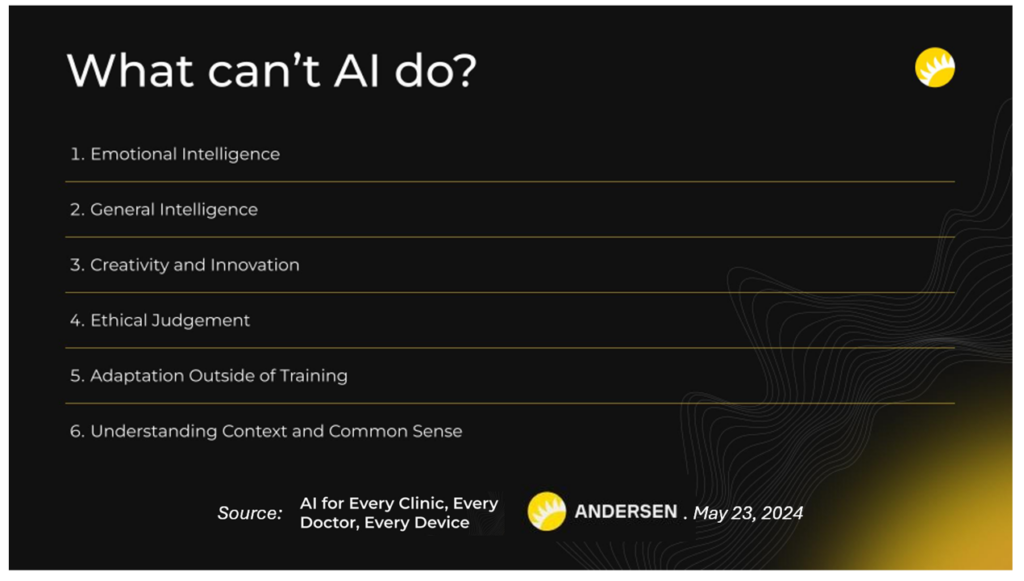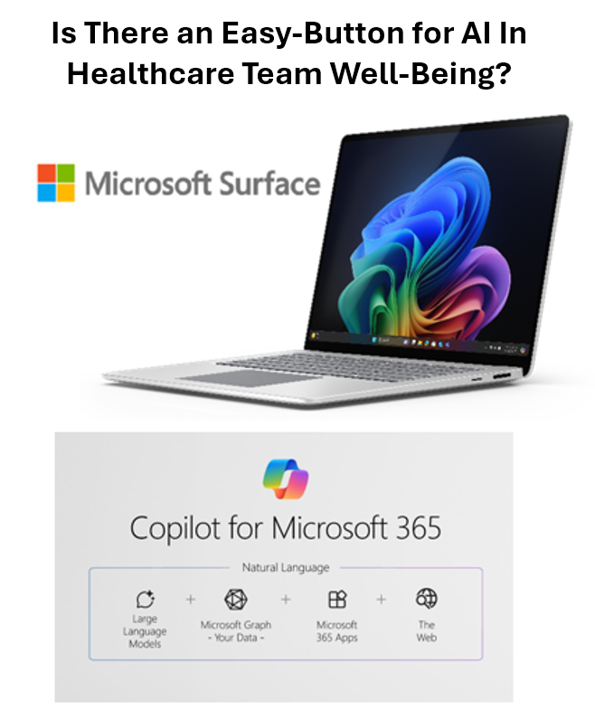“The greatest opportunity offered by AI is not reducing errors or workloads, or even curing cancer: it is the opportunity to restore the precious and time-honored connection and trust,” Dr. Eric Topol wrote in his 2019 book, Deep Medicine: How Artificial Intelligence Can Make Healthcare Human Again.
In the five years since Dr. Topol looked for AI to bolster the human-touch in health care, we’ve lived, worked, and muddled our way through the COVID-19 pandemic and witnessed the growing epidemic of burnout among clinicians, the front-line of medical care.
I recalled Dr. Topol’s assertion on AI’s promise for humanizing health care and trust when Microsoft asked me to look at the new Surface Laptop 6 that features a Copilot key on the keyboard.

I’ve worked long enough at the intersection of health and technology to know the temptation to identify tech in search of a problem – versus identifying a problem and then developing user-centered approaches to solving that challenge.
Recognizing and continuing to work on the challenge of clinician (and patient) burnout, I wondered: could this new Surface Laptop 6 be used by providers to help address burnout and friction in work-flows? Specifically, in addition to an “easy-button” on-ramp to Copilot AI for providers to click on, the device has faster performance supported by a new Neural Processing Unit (NPU) that could help make their work more productive with less friction – and thus support clinicians’ well-being?
Let me explain from a global to a local lens….
How AI can democratize and enchant health care – the WHO perspective
In January 2024 I explored the World Health Organization’s report on Ethics & Governance of Artificial Intelligence for Health in my Health Populi blog. The report’s six consensus principles have become a True North for me in my own evolution with AI for my clients in the health/care ecosystem and, indeed, for my own AI-“operating system” ethos. 
WHO’s six ethical pillars for AI in health speak to:
- Protecting autonomy
- Promoting human well-being, human safety, and the public interest
- Ensuring transparency, explainability and intelligibility
- Fostering responsibility and accountability
- Ensuring inclusiveness and equity, and,
- Promoting AI that is responsible and sustainable.
The prospect for AI-in-everyone’s-hand in the health care enterprise has the promise of these goals. To achieve that promise in health care would indeed require an enterprise-wide approach across all users.

So imagine Copilot AI deployed in every health and support worker’s hands to democratize exposure to and use of AI across the health care enterprise, becoming a normal part of workflow. Key to the potential power of this vision is that Copilot’s access to data would go across all aspects of Microsoft 365, from notes and text to apps and workflows – even within electronic health records (more on the example of Epic EHR below).
The micro-enterprise of the care team
As I think about the health care enterprise and care delivery at the point-of-patient, I’m envisioning a micro-enterprise of a multidisciplinary care team and supportive ancillaries like lab, radiology, and nutrition, for example. This graphic comes from Deloitte’s work on evolving team-based care, a good example of how such teams are developing. 
The “glue” and productive chassis for a team like the one pictured on the right is technology that’s well-designed for these users, their patients and family caregivers.
Hardware like the Surface Laptop 6 with its new features like the NPU, the larger vertical screen, and improved audio and graphic capabilities can be deployed to support the effectiveness, productivity, and well-being of team members – and their patients. Consider automating administrative tasks from patient scheduling appointment, supporting clinical decision making based on patient data across the continuum of care and regardless of site of care, easing clinical documentation, and providing real-time understanding of risks and areas for improvement.

Focusing in on The Quintuple Aim – care team well-being
Weaving together the WHO ethical principles with team-based care leads me to think about The Quintuple Aim, the five elements that the Institute for Healthcare Improvement identified for our True North for making health care better.
Among the five pillars shown in the graphic, we can start with the challenge of care team well-being and solving for clinician burnout. AI embedded into various workflows could address this epidemic which could have positive effects on the other four elements – enhancing the care experience, advancing health equity, improving population health, and lowering per capita costs.
Enhancing workforce well-being
Deloitte’s Life Sciences & Health Care team recently wrote about Restoring purpose in health care work through technology and workforce innovation. The report calls out the link between staffing shortages, workforce burnout, and lack of trust in leadership.

The table from Deloitte’s report details workflows for nurses with the opportunity for automation – and time saving. Imagine how Microsoft Copilot in the hands of a nurse or other patient-facing clinician could empower her to more efficiently document the conversation without the intrusion of a disruptive EHR checklist, or educate the patient on-the-fly with information Copilot suggests based on that conversation and diagnosis.
That’s just a quick snapshot of a nurse-patient encounter. Step back to consider the patient journey and continuum of care, from lab tests and radiology imaging to the nurse conversation, the physician exam, and follow-up with a specialist or nutritionist for food-as-medicine counsel.
Further value could be realized by integrating Copilot into the EHR. That’s already happening with Epic’s collaboration with Microsoft, and health systems expanding AI use across their own enterprises. With Epic in 38% of acute care hospitals (as of May 2024), their vision of democratizing and validating health AI will also help scale that easy-button for care.
What’s under the hood that could also enchant care teams
Overall, a Surface Laptop 6 with Copilot on-board in all healthcare-hands could reduce friction across the care continuum, and improve productivity through more seamless collaboration.
The Surface Laptop 6 also offers some physical features that could help health care teams’ workflows and technology enchantment such as:
- Aa vertically-larger screen (offering more visual real estate to look at data, images, and video) as well as that screen being
- Anti-reflective, which benefits clinicians working in highly-lit environments
- “Omnisonic” audio with speakers that remove background noise – very useful feature during virtual Grand Rounds or telehealth consultations
- Powerful performance enhanced through an “NPU” (complementing the CPU) which enables the device to perform faster and more efficiently while preserving battery life, and,
- Strong security especially important when leveraging large language models and processing large amounts of data
among other features.

The health/care community for AI beyond the PC…
In their assessment of “what AI can’t do,” the team at Andersen Lab pointed out that AI doesn’t have emotional intelligence, nor general intelligence, isn’t inherently creative or innovative, and lacks ethical judgment.
Thus, it’s encouraging to know that Microsoft has organized an effort to foster responsible AI principles as part of a collaborative called TRAIN, the Trustworthy & Responsible AI Network. Per their press release, TRAIN aims to “operationalize responsible AI principles to improve the quality, safety and trustworthiness of AI in health.”
Microsoft is working alongside innovative health care providers such as AdventHealth, Advocate Health, Boston Children’s Hospital, Cleveland Clinic, Duke Health, Providence, and other academic medical centers and systems, along with OCHIN and TruBridge, partners in community-based health. Together, these health care providers, large and small, serving megalopoles and smaller, hyper-local communities, can further foster AI’s adoption across the health care ecosystem.

In my journey considering how technology can benefit and not burn out health care providers, a faster, frictionless experience to support the individual clinician and care team can bolster health and well-being for both providers and patients.
The most impactful touchpoint for trust between a health care provider and a patient is her satisfaction with the services they receive – delivering a 4.6 times multiple on likelihood to trust that provider, Accenture reported in a recent study on patient loyalty in health care.
I return once again to Dr. Topol – and his thought that, “the greatest opportunity offered by AI is not reducing errors or workloads, or even curing cancer: it is the opportunity to restore the precious and time-honored connection and trust – the human touch – between patients and doctors.”





 Interviewed live on BNN Bloomberg (Canada) on the market for GLP-1 drugs for weight loss and their impact on both the health care system and consumer goods and services -- notably, food, nutrition, retail health, gyms, and other sectors.
Interviewed live on BNN Bloomberg (Canada) on the market for GLP-1 drugs for weight loss and their impact on both the health care system and consumer goods and services -- notably, food, nutrition, retail health, gyms, and other sectors. Thank you, Feedspot, for
Thank you, Feedspot, for  As you may know, I have been splitting work- and living-time between the U.S. and the E.U., most recently living in and working from Brussels. In the month of September 2024, I'll be splitting time between London and other parts of the U.K., and Italy where I'll be working with clients on consumer health, self-care and home care focused on food-as-medicine, digital health, business and scenario planning for the future...
As you may know, I have been splitting work- and living-time between the U.S. and the E.U., most recently living in and working from Brussels. In the month of September 2024, I'll be splitting time between London and other parts of the U.K., and Italy where I'll be working with clients on consumer health, self-care and home care focused on food-as-medicine, digital health, business and scenario planning for the future...